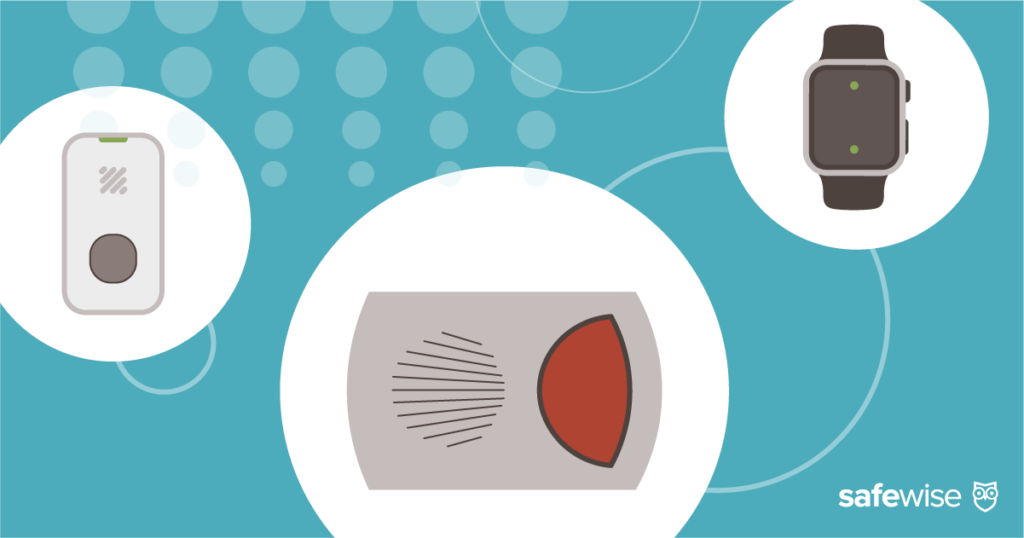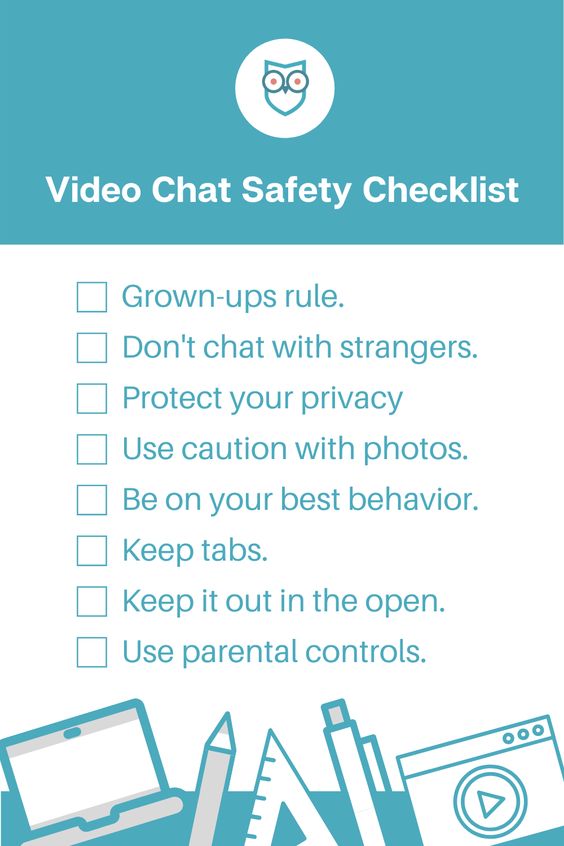Keeping your kids safe online can seem like a huge task. But you don’t have to go it alone. SafeWise has identified the top online threats to kids and tips for keeping kids safe.
Internet Safety Guide for Kids
For over 11 years, SafeWise experts have conducted independent research and testing to create unbiased, human reviews. Learn how we test and review.
- Top online threats for kids
- Compare top internet safety products
- How to protect your kids from cyberbullying
- How to protect your kids from online predators
- How to protect your kids from inappropriate content online
- Video: Online learning internet safety
- How to keep your kids safe during online learning
- How much is your state doing to keep kids safe online?
- Data: State-by-state online safety laws
- More resources for online safety
We’ve put together a free online safety contract that you can print out and share with your kids. Use it to help build a conversation around online safety and your expectations.
By signing up, you agree to our Terms and Conditions and Privacy Policy.
Top online threats for kids
There are a number of potential dangers in cyberspace, but these are the top online security risks that most kids face.
1. Cyberbullying: More than 36% of kids age 12–17 have been cyberbullied at some point in their life, and nearly 15% have bullied someone else online. Cyberbullying is any aggressive, threatening, or mean-spirited activity conducted via electronic communication (email, social media posts, text messages, etc.). Girls are more likely to be the victims of cyberbullying, and more boys admit to bullying others online.¹
2. Online predators: Adults who use the internet to entice children for sexual or other types of abusive exploitation are considered online predators. Child victims can be as young as 1 or as old as 17. When it comes to online enticement, girls make up the majority (78%) of child victims—while the majority (82%) of online predators are male. And 98% of online predators have never met their child targets in real life.²
3. Exposure to inappropriate content: Inappropriate content is one of the most common online threats that kids encounter. Everything from vulgar language and hate speech to graphically violent or sexual images can have a harmful effect on an impressionable child. Over 55% of tweens (kids age 10–12) have been exposed to violent content on the internet, and nearly 60% have come across sexually explicit words or images.³

4. Identity theft: While this is classically thought of as an adult issue, children are clean slates, making them the perfect targets for identity thieves. Without knowing what to avoid or mistrust online, your kids could give their own important information over to bad actors who could tank their credit long before they're able to open up their own lines.
NOTE: For the purposes of this guide, we’re focusing on the earliest prevention possible. While these internet safety tips for kids and parents can be applicable to anyone, we’ve selected steps to help protect children from ages 5 through 12.
Parental control apps like Bark help you monitor content across several platforms, manage screen time, filter inappropriate websites and set location alerts.
Info current as of post date. Offers and availability may vary by location and are subject to change.
Compare the best kids safety technology products
Info current as of post date. Offers and availability may vary by location and are subject to change.
*AngelSense $44.99 monthly cost for 1-year plan, paid upfront. Month-to-month plan with 1-year contract $49.99/mo. No contract service plan $64.99/mo.
We like smartwatches to help keep kids and parents in touch, but your child's device might not be welcome in the classroom. Schools are concerned about distraction, privacy, and cheating.
Be sure to talk to your child's teacher or principal before sending them to school with a smartwatch. And you can help educators out—use parental controls (it's called "Do Not Disturb" on the TickTalk 4) to shut down the device during class.
How to protect your kids from cyberbullying
Cyberbullying is a form of online harassment that can come from in-person peers or new people online. The exact signs of cyberbullying may look different from child to child, but red flags include apprehension or secrecy around digital activities, changes in mood or interests, and withdrawal from normal activities or friends.
1.Learn the tactics: Fake profiles, catfishing, blackmail, none of these tactics are off-limits for the worst cyberbullies. Whether your child tells you about the harassment or not, it helps to know how to identify cyberbullying in the wilds online.
2. Talk about it: Have ongoing discussions with your child and ask about websites, games, and friends they meet online. Be sure they understand what cyberbullying is and what it looks like when someone crosses the line. They should know that you're a safe person to talk to when they encounter something uncomfortable or upsetting online.
3. Keep a watchful eye: Parental control apps like Bark are especially helpful for keeping an eye on your kids' smartphone and tablet activity. For younger kids, consider using a shared email account for online profiles until they're old enough for their own.
4. Set boundaries: Put time limits on screen time. Include all online activities—from homework to playing games and surfing the web. Restrict social media access and email accounts, and set rules for any messaging, texting, etc. Let your kids know you’ll be checking in regularly. Be prepared to renegotiate boundaries as your child gets older or starts to use new technology.4
5. Build a network (IRL): They don’t say it takes a village for nothing. The more people you have looking out for your kid online, the more likely you are to keep them safe. Know your kids’ friends and their parents. Enlist support from school, sports, and church leaders.
6. Be prepared to respond: Don’t wait until the heat of the moment to come up with your game plan. In case your kid does get bullied online, learn what the proper responses are so you can keep your emotions in check and help your child deal with what they’re going through.
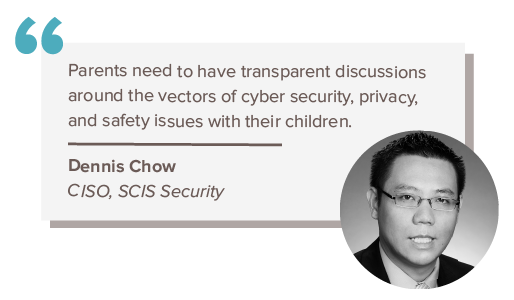
Steps to take if your child has been bullied
Pay attention: Look for signs of cyberbullying, like spending more time online or texting, hiding the screen from others, emotional responses to online interactions, and sadness or seclusion.
Ask questions: Gently ask your child what’s going on and how they feel about it. Find out if they’ve responded to the bully and what that response was.
Your child may feel frightened, angry, sad, or even betrayed if the bully is someone they trusted. Let them know it’s okay to feel whatever they’re feeling.
Block and report the bully: Immediately block (or “unfriend”) the abuser. Use tools like site blockers and privacy settings as extra layers of protection.
Alert the website, app, and email administrators to the bully. Most social media platforms offer options to report a user or flag dangerous posts. If appropriate, report the abusive activity to school or law enforcement officials.
Assess the damage and get support: If your child’s emotional response is extreme and protective measures don’t seem to help, seek the help of a licensed mental health professional.
Talk to other adults who can help protect your child (other parents, teachers, school administrators, coaches, etc.) and bolster your child’s positive friendships.
What to do If your child is the bully
Watch for signs: Cyberbullies show signs of their harassment just like kids on the receiving end. If your child seems to have a falling out with old friends or suddenly has a new friend group. If they're obsessing over social media and being online, if they're opening multiple accounts on the same platform, these can all point to your child harassing others.
Break the ice: Broach the topic with your child in a firm but open-minded way. They may become defensive or angry, but it's important to listen and remember that they may be in pain themselves. Be clear about the consequences of cyberbullying and harassment and offer help in the form of counseling or other resources.
Step in: After your discussion, it's time to enforce hard boundaries around their online behavior. Parental control apps can help you monitor their online activity, limit their screen time, and block apps and websites where they previously harassed others.
Offer support: Cyberbullying can be harmful to everyone involved. Along with your own child's mental health and habits, offer support to any children your kids may have hurt. Reach out to mental health professionals for counseling to help your child work through feelings that lead them to this behavior.
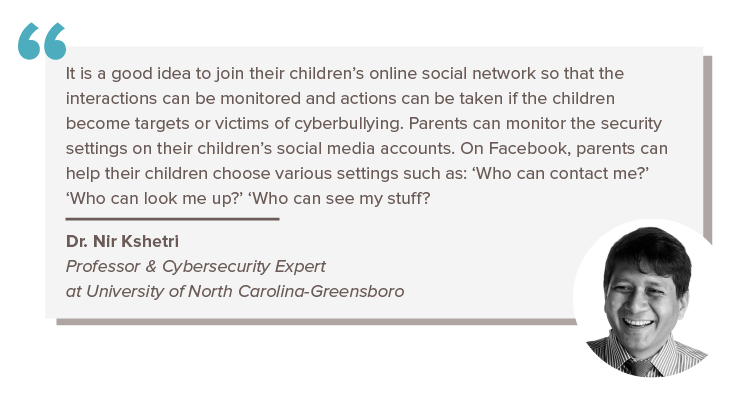
How to protect your kids from online predators
Online predators come in many forms. Whether they're after money, information, or worse. Many can be charming and friendly, earning your child's trust gradually. Protecting your kids from malicious behavior online requires you and your kids to know the risks and red flags that point to scammers and predators.
1. Be clear about the danger: While it can be hard to talk to your kids about scary subjects like online predators, it's important that they know what's out there.
Discussing what behavior to expect from new and familiar people can keep them safe. Fostering a healthy suspicion of new people online can keep them skeptical if a friendly stranger reaches out to them.
2. Guide online behaviors: Don't let them go online or use social media alone until they know the basics of online etiquette.
Without that foundation, they may share personal information, images, and details with strangers, putting them at risk. Boundaries like asking permission before accepting or sending friend requests are a good start for staying involved in their online life.
3. Rein in digital cameras: With cameras widely available on all our devices, it's important to monitor what kind of images your kids send and receive online.
Limit their access to a camera until they have a firm understanding of what images are safe to share and receive online.
4. Monitor online activity: Use a shared email account for your kids' online profiles, and if your family has a desktop, keep it in a common room.
Screen time limits and blocked websites for their own devices can keep them in safe online areas or at least under your digital wing until they're old enough to go online on their own.
5. Keep kids out of dangerous places: Talk about the risks of direct messaging and social networks, and set up rules and time limits if you allow your kids to use them. Always follow age restrictions for websites and apps.
6. Don’t let your guard down: Unfortunately, even “safe” places still require vigilance. There are kid-focused games and websites where predators may pose as children.
Consider limiting your kids to online communication with people they've only met in person to narrow any risk.
Steps to take if your child has been targeted online
- Cut off communication with the predator.
- Change online credentials, including screen names, usernames, and passwords.
- Save screenshots or copies of messages and images from the predator.
- Report the activity to website administrators and law enforcement.
- Seek professional help for your child as appropriate.
- Let your child know it’s not their fault.
Safety tips for kids
- Don't share personal information like addresses, phone numbers, or credit card information online.
- Ask an adult before sending or accepting friend requests and messages from strangers.
- Be picky about the photos you share online. You can't control what other people do with them or who they may share them with.
- Be suspicious of links, attachments, and gifts strangers send online. If they sound too good to be true, they probably are.
- Never agree to meet strangers alone IRL, even if they claim to be a kid too.
- Don't hesitate to ask your parents or another trusted adult for help. You may feel embarrassed at first, but they can help you more than anyone.
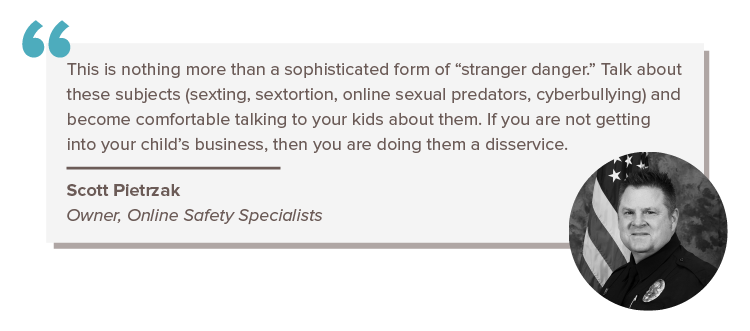
How to protect your kids from inappropriate online content
1. Teach kids how to navigate the internet: "Mature" websites featuring violent or sexual content can often be a gateway to malware, viruses, and other cyberthreats. Talk about proper online etiquette, how to enter safe search terms, how to identify a secure website (https), and when to ask an adult for help.
2. Let kids know what to watch for: Teach them that bad stuff can come from many sources, including email and direct messages. Talk about inappropriate websites, pop-up ads, and when and where it’s okay to click on something.
It also helps to know a little about their world too. Learn more about their favorite games and activities popular with your kids and their classmates. If you find these things inappropriate, it's worth talking to your kids about why you're concerned.
3. Explain email safety: Make sure kids know not to click on things or open attachments in emails and not to respond to messages from people they don’t know. Have them ask an adult before they download anything.
Phishing affects everyone online, so be sure you and your kids know the basics.
4. Set up firewalls and content blockers: Use the built-in safety applications that come on your devices and add more to be extra safe. Block all websites that aren’t rated safe for children. Use a content filter or firewall that is designed to protect children from harmful content.
5. Be prepared: Have a plan in place in case your child is exposed to graphic content online. Know what the proper responses are so you can focus on helping your child manage their feelings.
Steps to take if your child has been exposed to inappropriate content
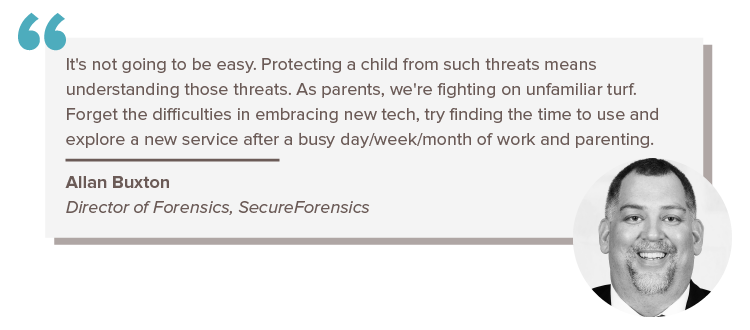
How to protect your kids from identity theft
Whether through social media, gaming, or exploring the web, around one in every 50 children has their identity stolen online.5 Identity theft at a young age can damage your child's chances for loans, credit cards, and other opportunities as an adult.
Warning signs of child identity theft
Just like adult identity theft, there will be signs if your child's identity is stolen.
Watch the mail for credit card bills and pre-approvals under your child's name. Some parents have even received notices from the IRS!
If the thieves are especially bad, your child's name may be passed on to debt collectors.6
What can parents do about child identity theft?
Our resident cybersafety expert, Pete Canavan, recommends a few proactive measures.
Start by signing your children up for credit monitoring service (Canavan recommends LifeLock). Be sure to put a freeze on all three credit reporting agencies and bank account systems with ChexSystems. Finally, freeze utility accounts if they exist with National Consumer Telecom & Utilities Exchange.
Be sure to store any of your child's important documents in a safe place and shred the ones they don't need anymore. When your child passes along an old electronic device to a sibling, or friend, sells or donates it, be sure it's been completely wiped of any identifying information.
And be sure your kids understand the gravity of what's at stake when you trust them online. They need to demonstrate mature online habits, knowing what is trustworthy and what isn't before they explore the web on their own.
Video: Online learning internet safety
Subscribe to our YouTube channel and learn how to protect your home, loved ones, and belongings.
How to keep your kids safe during online learning
Whether you and your kiddos are internet pros or getting online for the first time, we’ve got the tips you need to navigate learning online safely.
Tips for safe online learning
Just because your child goes online for school, it doesn’t mean there still aren’t potential dangers lurking. These best practices will minimize your child’s exposure to online risks no matter what platform or software their school is using.
1. Make sure websites are secure
You can instantly tell if any website is safe by looking for one letter: “s.” Every website address starts with the letters “http,” but you know a site is secure when you see “https.” That means the website itself is taking measures to keep users and their information secure while they use the site.
If you’re directed to any websites for school or entertainment that don’t have that extra “s” at the beginning of the address, steer clear.
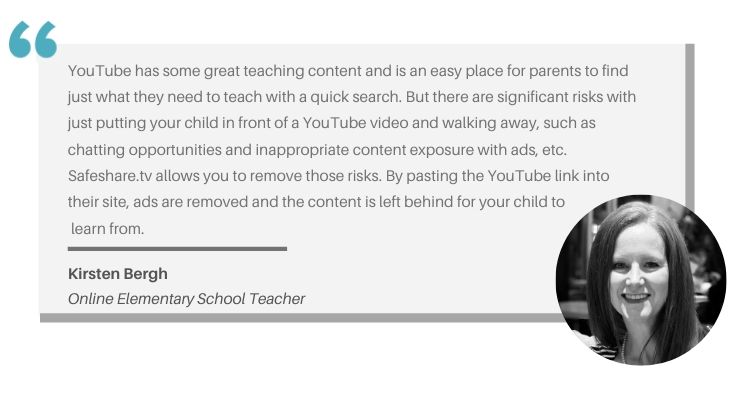
2. Guard personal information
This can get tricky when your child needs to be identified for schoolwork or classroom discussions, but personal details need to be guarded closely.
Chances are, your child probably already has a student identification number. Those kinds of identifiers are a great way to protect personal details from leaking on the internet.
None of the following information should be used to identify your child in class, on a list of posted grades, or in an online discussion.
- Full first and last name
- Social security number
- Birthdate
- Address
- Phone number
- Photograph
Your little one should also have a secure username and password to log into courses, lectures, and assignments.
3. Set up parental controls
You don’t have to purchase parental control software to protect your child during online learning. There are already a lot of helpful tools built into your device hardware, software, and internet browser.
Find tutorials here to help you maximize built-in privacy settings and content blockers.
- Parental controls for Apple products
- Parental controls for Google Play
- Parental controls guide for Chromebook
- Content restrictions for Windows 10 and Xbox One
- Parental controls for YouTube Kids
- Content filters on SafeSearch for Google
- Parental controls on Amazon FreeTime
- Parental controls on Netflix
If you want the extra reassurance of parental control software, we tested a bunch of them and picked our favorites. Almost every brand we recommend has a free version available, so you can probably upgrade from built-in parental controls without reaching for your wallet.
4. Keep everything updated
It seems too simple to be so effective, but one of the best ways to keep kids safe online is to make sure that all devices, software, and firmware are up to date.
Updates can seem like a pain, but one of the biggest reasons companies come out with new versions is to deploy security patches that address the most recent and innovative threats out there.
Plus, an outdated operating system or old version of software can render your parental controls and privacy settings useless.
"The website Teacherspayteachers is a wealth of printable and electronic teaching resources that are legit and vetted very well."
Kirsten Bergh, Online Elementary School Teacher
Prepare your kids for success with online safety tools
Tools to make the most of stay-at-home learning
How much is your state doing to keep kids safe online?
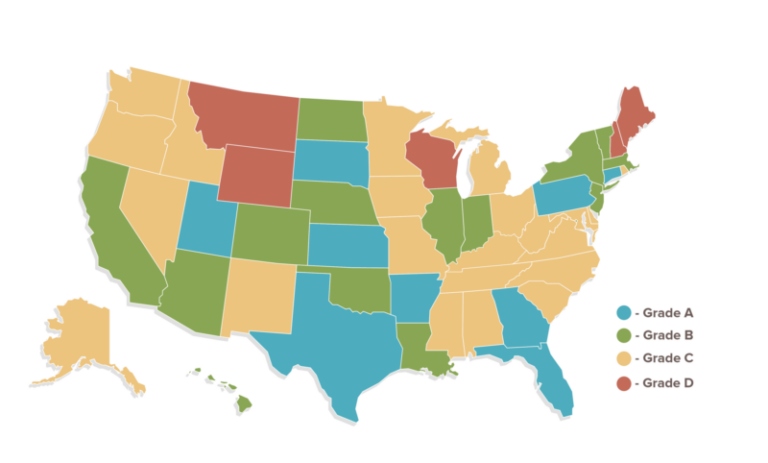
To grade each state, SafeWise looked at laws for both sexting and cyberbullying.7,8 Points were assigned to states based on the types of laws currently on the books and the consequences for violating those laws. If a state has a law proposed, partial points were granted. School policies and consequences were also factors. Letter grades were determined based on the total points, with higher points earning higher grades.
More resources to help with online safety for kids
This guide is the perfect starting point to make sure you know the basics for keeping kids safe on the internet. But online threats are constantly changing, and cybercriminals are getting more sophisticated. To help you stay ahead of the curve, here are some of the resources we recommend.
Internet safety classes and workshops
State and local internet safety resources
- Internet Crimes Against Children Task Force Program: State Chapter Directory
- Office for Victims of Crime: Providers/Community Leaders
- D.A.R.E.: Internet Safety
Tools to keep kids safe online
- FBI Safe Online Surfing (for students and teachers, 3rd through 8th grade)
- The Best Parental Control Apps and Software
- Guide to Parental Controls
- Internet Safety 101: Rules ‘N Tools Checklist (for parents and educators)
More educational and support resources
- KidsHealth Internet Safety (for parents, kids, teens, and educators)
- Internet Matters e-Safety Advice
- Good Pictures Bad Pictures Jr.: A Simple Plan to Protect Young Minds
- SafeKids.com: Internet Safety by Age
- Common Sense Media: Privacy and Internet Safety
- Is TikTok Safe? Here’s what you need to know
- What Is ChatGPT and Is It Safe for Kids?
Related articles on SafeWise
- iOS vs. Android Security: Which One Keeps Your Child Safer Online?
- What Age Should Kids Get a Phone?
- Best Identity Theft Protection
- 31 Surprising Identity Theft Statistics
- Best Antivirus for Android Devices
- Best Antivirus and Malware Software
- Best Password Manager for All of Your Devices
- 10 Cybersecurity Tips for Shopping Online
- Dangerous Apps for Kids
Sources
- Justin Patchin, Cyberbullying Research Center, “2019 Cyberbullying Data,” July 2019. Accessed April 11, 2023.
- National Center for Missing and Exploited Children, “The Online Enticement of Children: An In-Depth Analysis of CyberTipline Reports,” 2017. Accessed April 11, 2023.
- Haley Zapal, Bark, “2018 Children and Teen Cyber Fact Sheet,” January 2019. Accessed April 11, 2023.
- Kate Muir and Adam Joinson, Frontiers in Psychology, "An Exploratory Study Into the Negotiation of Cyber-Security Within the Family Home," March 2020. Accessed April 11, 2023.
- Javelin Strategy, "Child Identity Fraud: A Web of Deception and Loss," Accessed July 2024.
- Norton LifeLock, "Child identity theft: How to help protect your child," Accessed July 2024
- Sameer Hinduja and Justin Patchin, Cyberbullying Research Center, “State Sexting Laws,” November 2018. Accessed April 11, 2023.
- Sameer Hinduja and Justin Patchin, Cyberbullying Research Center, “State Cyberbullying Laws,” January 2021. Accessed April 11, 2023.
Recent Articles


